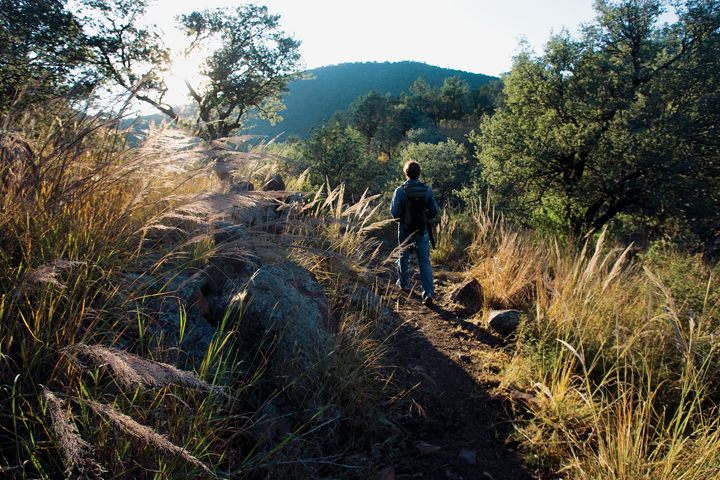 Determined to take a West Texas walk one particularly blustery spring day, my son and I blew into Fort Davis. Almost literally. A warm tail wind out of Marfa swept us up into the desert frontier town—at an altitude of 5,050 feet, the highest town in Texas. The former cavalry outpost (the fort was active from 1854-1891) usually boasts a pleasant Denver-without-snow climate, but when La Niña blasts, she gets your full attention. Grit in the teeth aside, altitude and climate make the surrounding Davis Mountains a favorite among hikers and bikers. On the other hand, rugged terrain and private land holdings mean that the most extensive mountain range in the state has only limited public access.
Determined to take a West Texas walk one particularly blustery spring day, my son and I blew into Fort Davis. Almost literally. A warm tail wind out of Marfa swept us up into the desert frontier town—at an altitude of 5,050 feet, the highest town in Texas. The former cavalry outpost (the fort was active from 1854-1891) usually boasts a pleasant Denver-without-snow climate, but when La Niña blasts, she gets your full attention. Grit in the teeth aside, altitude and climate make the surrounding Davis Mountains a favorite among hikers and bikers. On the other hand, rugged terrain and private land holdings mean that the most extensive mountain range in the state has only limited public access.
My 10-year-old and I had already hiked the trail between the old fort and Davis Mountains State Park (fabulous views) and declared the Chihuahuan Desert Research Institute’s trails a flora fiend’s delight. This trip I’d promised Elliott he’d be one of the first to goat-leg it up the Nature Conservancy’s newly opened Madera Canyon Trail—a little thing like gusting 50-mph wind isn’t going to stop him. (In the spirit of full disclosure, trail’s-end enticements include root-beer floats at the Ft. Davis Drugstore’s famed soda fountain and a dip in the Hotel Limpia’s pool.)
We battle the wind past the Jeff Davis County Courthouse to the Nature Conservancy offices, where we meet Colin Shackelford, Stewardship Director of the Davis Mountains Preserve and our day’s companion. Hale and hearty despite a week of fighting wildfires, Shackelford is no stranger to hard work, but, he says, blazing a trail was new to him. Hired after the Madera Canyon Trail plans were in motion, Shackelford says his background in plant community ecology provided him “next to nothing” in the way of trail-building experience. For trail building, he relied on expert stonemasons (with technical rockwork experience) and direction from an expert on trail layout on loan from Big Bend National Park. Shackelford’s team completed the task with almost 2,000
hours of volunteer labor, and Madera Canyon Trail—opened to the public in October 2007—is now ours for the tackling.
Leaving town, the hoodoos (vertical columns of basalt characteristic of the foothills) stand sentinel at The Fort Davis National Historic Site and mark our way as we wind up past Davis Mountains State Park (home to Indian Lodge, one of the state’s most unusual historic hotels). Heritage cow-calf operations still predominate the landscape, although increasing numbers of weekend and retirement cabins dot the mountainsides. Still, Fort Davis remains a soothing settlement of 1,050 souls. It’s isolated enough that a big grocery-shopping trip involves a couple of ice chests and a two-hour drive to Midland.
Sixteen miles northwest of Fort Davis, we pass the turn-off to Mount Locke (altitude 6,800 feet) and the McDonald Observatory, the third-largest observatory in the United States (the visitor’s center and scheduled star parties are not to be missed). Shackelford points out a large area still smoldering from the fire he’d helped battle during the past week. Even though wildfires—this one spontaneously ignited from a pile of horse manure—can wreak havoc, controlled proactive burning is one of the Conservancy’s missions.
“Pine forests need to have lots of low intensity fires to replant themselves and maintain a diversity of habitat,” Shackelford says. Fortunately, volunteers did a superb job of keeping this 700-acre fire in check, saving homes as well as the largest private observatory in the country, under construction behind the home of a local comet specialist. The stars at night are truly big and bright in this part of Texas.
We see ponderosa pine in protected draws as we climb past a better-thighs-than-mine bicyclist laboring against the wind and elevation at Elbow Canyon. Beyond him, Pine Peak points into Big Sky blue; at 7,900 feet, it’s second only to Mt. Livermore, which tops out at 8,382 feet. All around us, the aptly named stands of scaly alligator juniper and piñon pine appear. Above us the elusive Southwestern white pine comes into view. Crossing Madera Creek at the old Fisher Ranch, we soon turn in at the Lawrence E. Wood picnic area, acclaimed as the highest roadside park in Texas, its meadowland appeal
picnic-perfect. Unbelievably, given that our visit heralds the beginning of Spring Break, the park (which is also the trailhead for the Madera Canyon Trail) is empty. As soon as he can dodge my slathering of sunblock, Elliott makes a slippery escape, visions of black-chinned hummingbirds and acorn woodpeckers calling him.
Thanks to the hot La Niña wind blowing in from the Chihuahuan Desert, hiking conditions approximate those of a convection oven, and I know I will be a walking piece of beef jerky if I don’t keep drinking water. Unlike El Niño and his usual escort of cool rain, La Nina’s winds are drier and hotter, with more lightning than moisture.
Shackelford, despite a sleepless week and a twisted ankle, is an enthusiastic hiking companion who offers a naturalist’s insights as we climb. He had predicted Elliott would soon leave us behind, and indeed we can scarcely stop him long enough to encourage him to embrace the armor-like bark of a ponderosa pine. “Smell it,” Shackelford says. As the boy goes snout-to-chunky bark, I see his eyes widen at the whiff that is pure butterscotch. It’s a sensory bonus that ups tree-hugging by a nose.
Strolling and jabbering, we discuss how the Davis Mountains form a “sky island” where animals and plants living above 5,000 feet are isolated from other mountain ranges by distance. Like the Galapagos, these ecological islands isolate species of flora and fauna found nowhere else on the planet. Mount Livermore’s sandwort and three-banded snails are but two examples. The Nature Conservancy’s Davis Mountain Preserve covers a big chunk of land, but much of it is inaccessible to the public except by prior arrangement or for special events. The Madera Canyon Trail, open to the public 365 days a year, is a fantastic entree to vistas, fauna, and wildlife not easily seen elsewhere. While the trail offers a decent 2.4-mile loop of length, the 175-foot rise in elevation (to 6,050 feet} means it is doable, even in today’s desiccating wind. The gentle elevation is only moderately difficult, and much of the path is more like a stroll in a rough-hewn garden. When the slight climb opens up to the highland vistas, the views are jaw-droppingly beautiful.
That’s the good news. We soon see evidence of one of the area’s biggest (and most aggressive) environmental threats: feral hogs. One collapsing hillside aside the trail looks as if it’s suffered a small earthquake. Aggressive rooting of the animal is equal to the land-moving power of a bulldozer. The destructive behavior results in major denuding, erosion, and loss of habitat for more desirable critters like the Montezuma quail. Magnifying the problem is
the hog’s ability to quickly adapt to efforts to eliminate it and then successfully thwart those plans. Even the success of helicopter trapping was short-lived, as the beasts soon adopted a nocturnal schedule of pillaging. They’re similar to fire ants in their tenacity and pervasiveness, but, as Shackelford says,
think of 300-pound fire ants. And because hogs breed like rabbits, the population is exploding exponentially.
Soon we must choose between a shortcut to the Chico Tank Dam or a path to a scenic overlook and around the 2.4-mile loop to catch the dam and Chico Creek on the flipside. We decide to head up, and the incline steepens by a gentle eight percent. Piñon rice grass and blue stem soften the landscape, but
the volume of rockwork involved in the construction of this trail—often precipitous mosaics of precision—easily explains the thousands of hours of volunteer handwork. At the apex of the climb, we are rewarded by a bench overlooking the Fisher Ranch. A red-shafted flicker glides by like a superhero. As we sit, I consider the Nature Conservancy’s goal to save at least 10 percent of every habitat in the world. With a combination of land purchases and the donation of conservation easements, roughly 90,000 acres of the Davis Mountains are now under protection.
A red-tailed hawk sails above us as we make our way to the Chico Dam, a rock damn built in the 1930s by ranchers to water their cattle. From this point, we’re heading down, and Elliott has a question. I’m thinking it will be about area fossils, why antelope can’t jump, or something about hogs. But you never
know on a day like this what observation might puzzle a boy. “Mom,” he asks, “what were you thinking when you wore lipstick today?”
Near trail’s end, we sit down a final time. It’s a mistake. Even on a little hike like this one, sitting down this late in the game can have a fatal impact on
momentum. Elliott, dehydrated from running at full tilt for a couple of hours, is now like a clockwork toy that has wound down. He begs to sit for longer. I whisper tales of the heaping plates of biscuits and porkchops that await us for dinner at the Hotel Lirnpia, and he makes a final sprint to the car.
That night, when he’s eaten to his heart’s content (including a salad, which is a deeply meaningful comment when you’re talking about a 10-year-old boy), he collapses into a hammock and closes his eyes. I can almost hear his batteries recharging. “Mom,” he says, “can we go to the Blue Agate Rock Shop tomorrow after we swim and then check out the gift shops and then,” he takes a deep breath, “let’s make the hike again tomorrow.” I have only one question. “Can I wear lipstick?”
STAY/PLAY FORT DAVIS
Fort Davis, the county seat of Jeff Davis County, is at the intersection of Texas 17 and Texas 118, 80 miles northeast of Presidio and 210 miles southeast of El Paso. See map on page 23. Call the Chamber of Commerce at 800/ 524-3015; www.fortdavis.com.
For more information on the Madera Canyon Trail, contact the Nature Conservancy, West Texas Program Office (Alpine), 432/ 837-5974; www.nature.org.
Davis Mountains State Park, 2,709 acres, 4 miles north of Fort Davis. Enjoy Skyline Drive, a paved road that climbs steeply to two overlooks on the east side of the park, with views of the Chinati Mountains 75 miles to the southwest. Access to Skyline Drive after 10 p.m. for stargazing is permitted with registration and payment of fee at the park office. Call 432/ 426-3337; www.tpwd.state.tx.us. The park’s hotel, Indian Lodge, was built in the Pueblo Style in the 1930s by the Civilian Conservation Corps. Make reservations well in advance for one of its 39 rooms. Call 432/ 426-3254; www.tpwd.state.tx.us.
The Visitors’ Center, outdoor exhibits, botanical gardens, a greenhouse, and hiking trails of the Chihuahuan Desert Research Institute are 4 miles south of
Fort Davis, on Texas 118. The Nature Center sits at an elevation of 5,060 ft. and covers 507 acres. Hours: Mon-Sat 9-5; closed on major holidays. Call 432/ 364-2499; www.cdri.org.
Hotel Limpia is at 100 State St., 432/ 426-3237 or 800/ 662-5517; www.hotellimpia.com.
Blue Agate Rocks & Gifts is at 603-A N. State St.; 432/ 426-2924. Polished and rough rocks, tumbling supplies, jewelry, geodes, artifacts, healing stones, and useful insider information from owner Donna Trammell.








